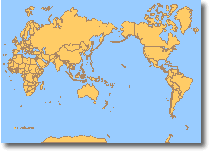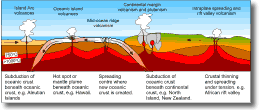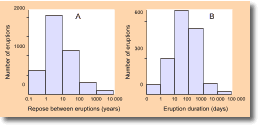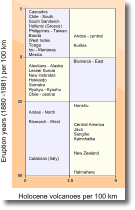
Occurrence and TypeDistribution of volcanoes view video of 1995 eruption of Mt Ruapehu, New Zealand. Volcanoes at divergent plate margins (e.g. Iceland) and hot spots (e.g. Hawaii) mostly erupt oceanic basaltic type magmas (with < 53% SiO2). Most of the energy released during these eruptions is as heat, with only small amounts of kinetic energy release through lava flows, lava-fountaining and minor explosions. Convergent margin volcanoes generally release far more explosive kinetic energy. Convergent margin volcanoes include those at sites of continental-oceanic crust collision (e.g. the Taupo Volcanic Zone volcanoes, the Andes), sites of oceanic-oceanic crust collision (e.g. the Tonga-Kermadec Island arc, the Aleutians), and also sites of continental-continental crust collisions (e.g. Italy). Convergent margin volcanoes generally erupt andesitic magmas (53-63% SiO2), but can also erupt more silicic magmas including dacite and rhyolite (> 63% SiO2).
Types of eruptions Volcanic eruption types vary considerably and depend on many factors including: magma composition, vent size and shape (i.e. confined pipes versus elongate fissures), magma volume, vent location (i.e. under water or on top of a mountain), external water and many other elements. Consequently, classification of eruption types is difficult, and most schemes contain problems. In the scheme presented here (Table 1), eruptions are categorised into 10 types in order of increasing hazard potential. These types range from non-explosive eruptions with slow-moving products that affect small areas, to huge, explosive eruptions with rapidly moving products affecting large areas. One limitation of this scheme is that most eruption types are named after volcanoes that show a particular style of behaviour, e.g. Strombolian (Stromboli in Italy), Surtseyan (Surtsey in Iceland). However, these volcanoes can produce periods of quite different styles of activity than what is characteristic of their respective eruptive types. In addition, an eruption may change as it progresses and go through phases of different eruption types, e.g. the 1883 eruption of Krakatau, changed from Vulcanian type activity to powerful Plinian and Peléean activity as it reached its climactic phase. Eruption character may also vary from place to place on a volcano, e.g. in 1906 on Vesuvio, the main vent ejected huge quantities of pumice and tephra, whilst effusive emission of lava occurred from several other vents.
Table 1. Eruption types (adapted from Blong, 1984).
Of the 5564 eruptions recorded up to 1981, 24% involved lava flows, c. 9% were of phreatomagmatic type, 5% produced pyroclastic flows, c. 5.5% generated mudflows (lahars) and 6% were submarine eruptions. Over 70% of the recorded eruptions involved “normal” explosive activity, involving activity of Strombolian, Vulcanian or Plinian type. Activity of volcanoes Volcanoes are often classified as either being active, dormant or extinct. However, this classification is often misleading because it is based on activity (or absence of it) in the known historic record. The length of reliable historic records vary from >2000 years in some places to <100 years in other places in the world. However, the recurrence interval of eruptions from some volcanoes can be much longer than any of the historic records. Also the early portion of many historic records are unreliable. In addition, this classification does not work for volcanoes that are monogenetic, (i.e. they erupt only once), e.g. Auckland is built over c. 50 monogenetic volcanoes, none of which are ever likely to erupt again (although a future eruption from the Auckland volcanic field is probable). Many "extinct" volcanoes have been known to erupt; one estimate is that on average one "extinct" volcano erupts every 5 years. An improved terminology is that of “alive” and “dead” volcanoes, based on the probability that they will or will not erupt again. This probability is based upon the geologic and historic record of the volcano and is expressed as the ratio between the time since the last eruption and the length of the longest repose period at that volcano. The smaller the ratio - the greater the probability of a future eruption. In the Holocene (last 10 000 years) 5564 eruptions are known to have occurred from 1343 volcanoes, and 529 of these occurred in the historic period. Hence, it is likely that many more of the world’s c. 10 000 volcanoes are likely to become “active” in the future. The duration of volcanic eruptions is also highly variable (Fig. 3B). Of the known 2139 eruptions (prior to 1981) the median duration is about 60 days. However, an eruption can comprise many different events over a long period of time, e.g. Sakurajima (Japan), has been in continuous eruption since 1955, with explosions occurring on most days, and the current eruption of Stromboli began before 450 B.C. It is the climactic phase of eruptions which is the most important from a hazards perspective, and in most cases these are of relatively short duration (e.g. Table 2). The Mt. St. Helens eruption began on March 17, 1980, and continued through 1983, however many peoples’ perceptions of this event were that each of the most violent outbursts was a separate eruption. Throughout this long eruption time, the most violent phase lasted only 9 hours, on May 18. Volcanoes on convergent plate margins erupt only 10-13% of the magma reaching the earth’s surface annually. However, these volcanoes provide 84% of know eruptions, and of importance from a hazards perspective, is that they also provide 88% of the eruptions with fatalities. Table 2. Duration of climatic eruptive phases, adapted from Blong (1984).
The eruption frequency-duration for each convergent margin volcano belt has been assessed by calculating the number of years each volcano in a belt has been active since 1880, then totalling these and dividing by the length of the belt. This indicates that the Halmahera (Indonesia), Calabria (Italy) and New Zealand belts have been the most active (Fig. 4). However, these areas may not be those of greatest volcanic hazard. There are several different parameters to quantify the size of a volcanic eruption. These include: Magnitude - the total volume of erupted material Intensity - the volumetric (or mass) discharge rate of material from the vent Dispersive power - the area over which eruptive products are distributed Explosive violence Destructive potential. One of the more commonly used methods to measure an eruption’s size is to estimate the total thermal energy released, based on a calculation using the total volume of ejected material. In a moderately large eruption (Table 3), 1015-1018 joules of energy are released (compare to a 1 kilotonne atomic bomb which releases about 4 x 1012 J). However, this measure does not always provide a good correlation with the degree of volcanic hazard from an eruption. A good example of this is that the violently explosive and extremely deadly eruption of Krakatoa in 1883 released only the same amount of energy as quiet, non-explosive eruptions of Mauna Loa in Hawaii in 1859 and 1950 (Table 3). Table 3. Eruption magnitudes of well known historic eruptions of the world, adapted from Blong (1984).
The most appropriate measure of an eruption size for volcanic hazards is the volcanic explosivity index (VEI). This index combines the total volume of erupted products, the eruption column height, the duration of the main eruptive phase and several descriptive terms. The VEI scale ranges from 1-8 in order of increasing explosivity (e.g. Table 3). The historic eruption of greatest VEI was that of Tambora (Indonesia) with a value of 7, no historic eruptions with a VEI of 8 have occurred. Over half the volcanoes for which information exists have had “large eruptions” of VEI 3 or greater. Volcanic hazards overview Convergent margin volcanoes are in general characterised by more explosive eruptions than other volcanoes, although they do no erupt more frequently or for longer periods. Hence the typical convergent margin volcano eruption would generally display one or more of the eruption types in the lower half of Table 1. Conversely, volcanoes at divergent margins or hot spots generally display the eruption types in the upper half of Table 1. This produces large differences in hazard potential and type. The relationship between the type of eruption, the type of hazard, relative frequency of damage, and range at which damage occurs is summarised in Table 4. In this classification, nine types of volcanic hazards are recognised. Table 4. Summary of volcanic hazards, adapted from Blong (1984).
Hazard level indicates the relative frequency of deaths if the specific type of activity occurs A = always, VF = very frequent, F = frequent, C = common, R = rare, VR = very rare. Tephra falls, ballistic projectiles, atmospheric effects, earthquakes, and acid rains and gases appear to be the most frequently occurring volcanic hazards, although the severity of these hazards varies considerably. In historical examples it can be difficult to attribute fatalities to specific types of hazard. However, from the known data since 1600 AD, pyroclastic flows and tsunamis have been the most hazardous volcanic events. Since 1900 AD, volcanically-generated tsunamis were not so deadly, but pyroclastic flows remained as the greatest hazard. Lahars and tephra fall are also among the most hazardous of events with the other types of hazard much less important. The limitation of these reviews is however that the results are heavily biased by a few eruptions that caused a large number of fatalities.
|
|||||||||||||||||||||||||||||||||||||||||||||||||||||||||||||||||||||||||||||||||||||||||||||||||||||||||||||||||||||||||||||||||||||||||||||||||||||||||||||||||||||||||||||||||||||||||||||||||||||||||||||||||||||||||||||||||||||||||||||||||||||||||||||||||||||||||||||||||||||||||||||||||||
|
|||||||||||||||||||||||||||||||||||||||||||||||||||||||||||||||||||||||||||||||||||||||||||||||||||||||||||||||||||||||||||||||||||||||||||||||||||||||||||||||||||||||||||||||||||||||||||||||||||||||||||||||||||||||||||||||||||||||||||||||||||||||||||||||||||||||||||||||||||||||||||||||||||




